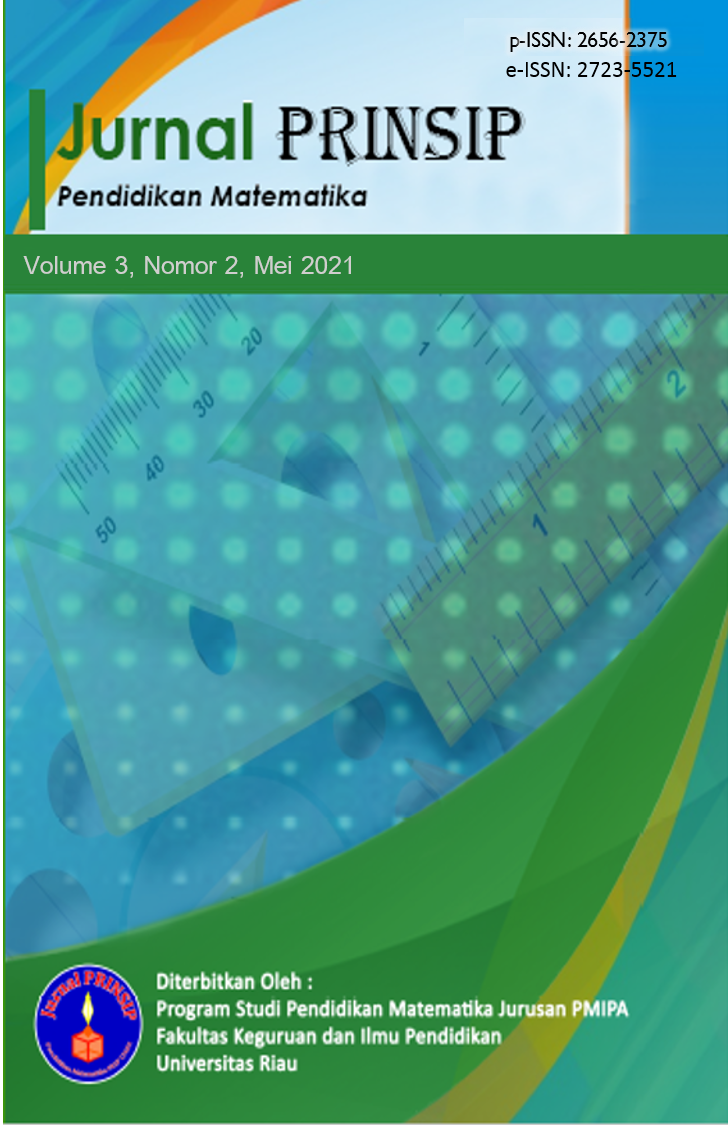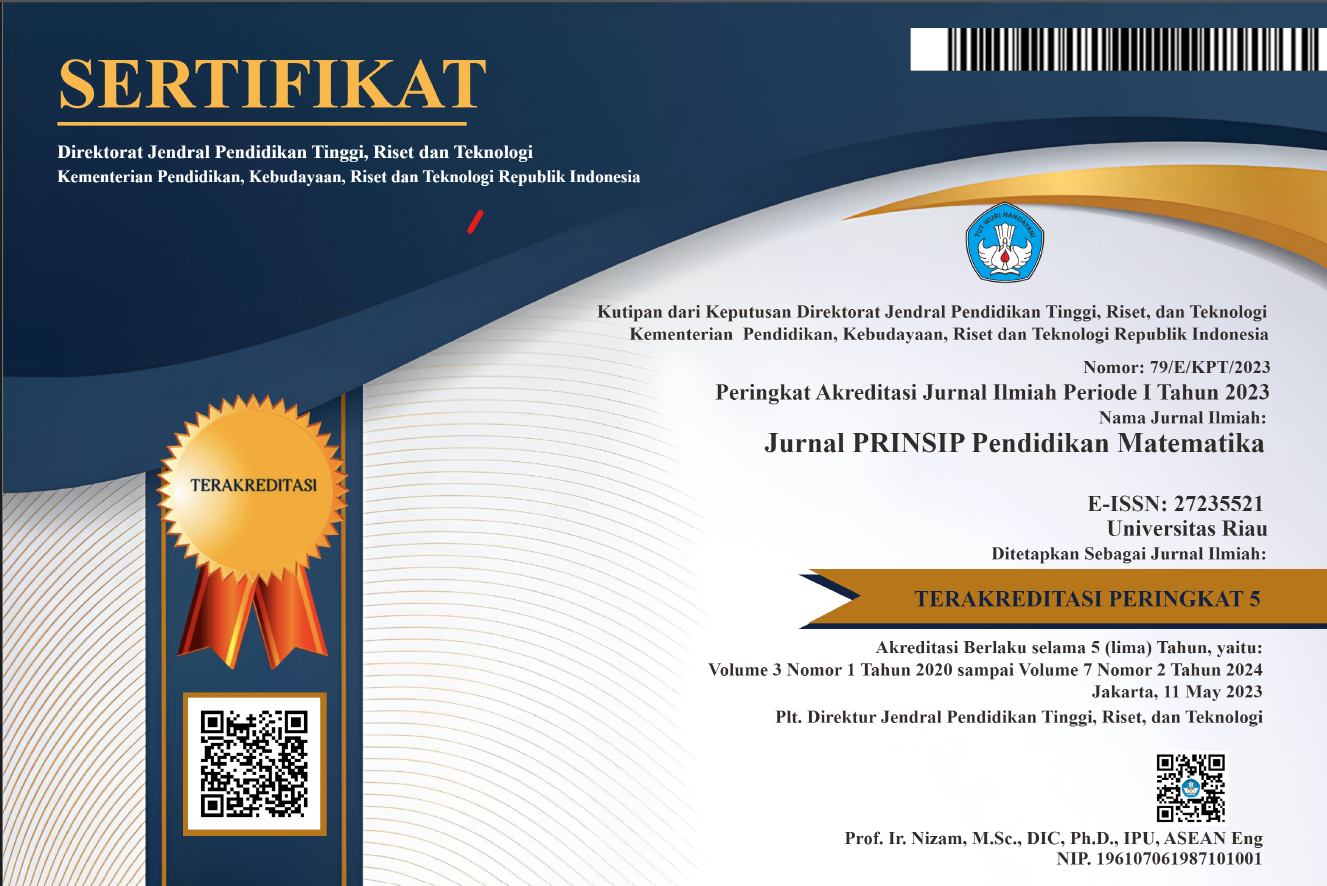THE EFFECT OF APPLICATION OF SEARCH, SOLVE, CREATE, AND SHARE (SSCS) LEARNING MODEL ON STUDENTS' MATHEMATICS COMMUNICATION ABILITY BASED ON PREVIOUS KNOWLEDGE IN MATHEMATICS IN JUNIOR HIGH SCHOOL
Abstract
This research aimed at investigating whether there was or not a difference on mathematical communication ability between students taught by using Search, Solve, Create, and Share (SSCS) learning model and those who were taught by using conventional learning; knowing whether there was or not a difference on mathematical communication ability among students having high, medium, and low prior knowledge in mathematics; and seeing whether there was or not an interaction between students’ prior knowledge in mathematics and SSCS learning model toward their mathematical communication ability. This study is a quasi-experimental study with a posttest-only control group design. The population in this study were all seventh grade students of SMP Negeri 3 Tambang for the 2019/2020 academic year. The sample in this study was class VII.1 as the experimental class and class VII.3 as the control class which was selected using simple random sampling. The data were collected using a test technique in the form of a test instrument for mathematical communication skills and PAM test questions. Analysis of the data used for hypotheses 1, 2 and 3 using a two-way ANOVA test. The results of data analysis show that there are differences in mathematical communication skills between students who follow the SSCS learning model and students who follow conventional learning, there are differences in mathematical communication skills between students who have high, medium and low PAM, and there is no interaction of PAM factors on mathematical communication skills. students at SMP Negeri 3 Tambang.
Downloads
References
Arief S. Sadiman. (2012). Media pendidikan: pengertian, pengembangan, dan pemanfaatannya. Rajawali Pers.
Choridah, D. T. (2013). Peran Pembelajaran Berbasis Masalah untuk meningkatkan kemampuan komunikasi dan berpikir kreatif serta disposisi matematis siswa SMA. Infinity Journal, 2(2), 194–202. https://doi.org/10.22460/infinity.v2i2.p194-202
Fahradina, N., Ansari, B. I., & Saiman. (2014). Peningkatan kemampuan komunikasi matematis dan kemandirian belajar siswa SMP dengan menggunakan model Investigasi Kelompok. Jurnal Didaktik Matematika, 1(1), 54 - 64
Hadi, S., & Novaliyosi, N. (2019). TIMSS Indonesia (Trends In International Mathematics And Science Study). Prosiding Seminar Nasional & Call For Papers, 0(0). http://jurnal.unsil.ac.id/index.php/sncp/article/view/1096
Hamdani, H. (2009). Pengembangan pembelajaran dengan Mathematical Discourse dalam meningkatkan kemampuan komunikasi matematik pada siswa Sekolah Menengah Pertama. Seminar Nasional Matematika Dan Pendidikan Matematika Jurusan Pendidikan Matematika FMIPA UNY 5 Desember 2009, 163 - 173
Kumalaretna, W. N. D., & Mulyono, M. (2017). Kemampuan komunikasi matematis ditinjau dari karakter kolaborasi dalam Pembelajaran Project Based Learning (Pjbl). Unnes Journal of Mathematics Education Research, 6(2), 195–205.
Lestari dan Yudhanegara. (2017). Penelitian pendidikan matematika. PT. Rafika Aditama.
Liliasari dan Rahmatan. (2012). Pengetahuan awal calon guru Biologi tentang konsep Katabolisme Karbohidrat. Jembrana.
Mulyana, Y., Priyatno, S., & Dewi, N. R. (2018). Penerapan model SSCS untuk meningkatkan kemampuan membuat model matematis dan kerja sama siswa. PRISMA, Prosiding Seminar Nasional Matematika, 1, 225–232.
Nufus, H., & Ariawan, R. (2017). Keterkaitan hubungan antara kemampuan komunikasi dan penalaran matematis siswa. Symmetry: Pasundan Journal of Research in Mathematics Learning and Education, 2(1), 29–42. https://doi.org/10.23969/symmetry.v2i1.240
Nurapriani, F. (2016). Meningkatkan kemampuan komunikasi dan koneksi matematik siswa SMP melalui strategi Think Talk Write. Buana Ilmu, 1(1), 45 - 55. https://doi.org/10.36805/bi.v1i1.97
Qonaah, A., Pujiastuti, H., & Fatah, A. (2019). Pengaruh Model Pembelajaran Generatif terhadap peningkatan kemampuan komunikasi matematis ditinjau dari kemampuan awal matematis siswa. Edumatica : Jurnal Pendidikan Matematika, 9(1), 9–14. https://doi.org/10.22437/edumatica.v9i1.6109
Rhozy, F., Darvina, Y., & Murtiani, M. (2016). Pengaruh penerapan model pembelajaran Search, Solve, Create and Share (SSCS) berbantuan bahan ajar bermuatan karakter untuk meningkatkan hasil belajar fisika siswa kelas XI SMAN 12 Padang. Pillar of Physics Education, 7(1), 81 - 88. https://doi.org/10.24036/1993171074
Risnawati. (2008). Strategi pembelajaran matematika. Suska Press.
Ruslan, & Santoso. (2013). Pengaruh pemberian soal Open-Ended terhadap kemampuan penalaran matematis siswa. Kreano, Jurnal Matematika Kreatif-Inovatif, 4(2), 138 - 150.
Satriawan, R. (2017). Keefektifan model Search, Solve, Create, and Share ditinjau dari prestasi, penalaran matematis, dan motivasi belajar. Jurnal Riset Pendidikan Matematika, 4(1), 87–99. https://doi.org/10.21831/jrpm.v4i1.7863
Son, A.L. (2015). Pentingnya kemampuan komunikasi matematika bagi mahasiswa calon guru matematika. Journal Universitas Wiralodra, 7(1), 33 - 40
Sumaryanta, S., Priatna, N., & Sugiman, S. (2019). Pemetaan hasil Ujian Nasional matematika. Ideal Mathedu: Indonesian Digital Journal of Mathematics and Education, 6(1), 543–557
Umar, W. (2012). Membangun kemampuan komunikasi matematis dalam pembelajaran matematika. Infinity Journal, 1(1), 1–9. https://doi.org/10.22460/infinity.v1i1.p1-9
Copyright (c) 2021 Jurnal Prinsip Pendidikan Matematika

This work is licensed under a Creative Commons Attribution-NonCommercial-ShareAlike 4.0 International License.





